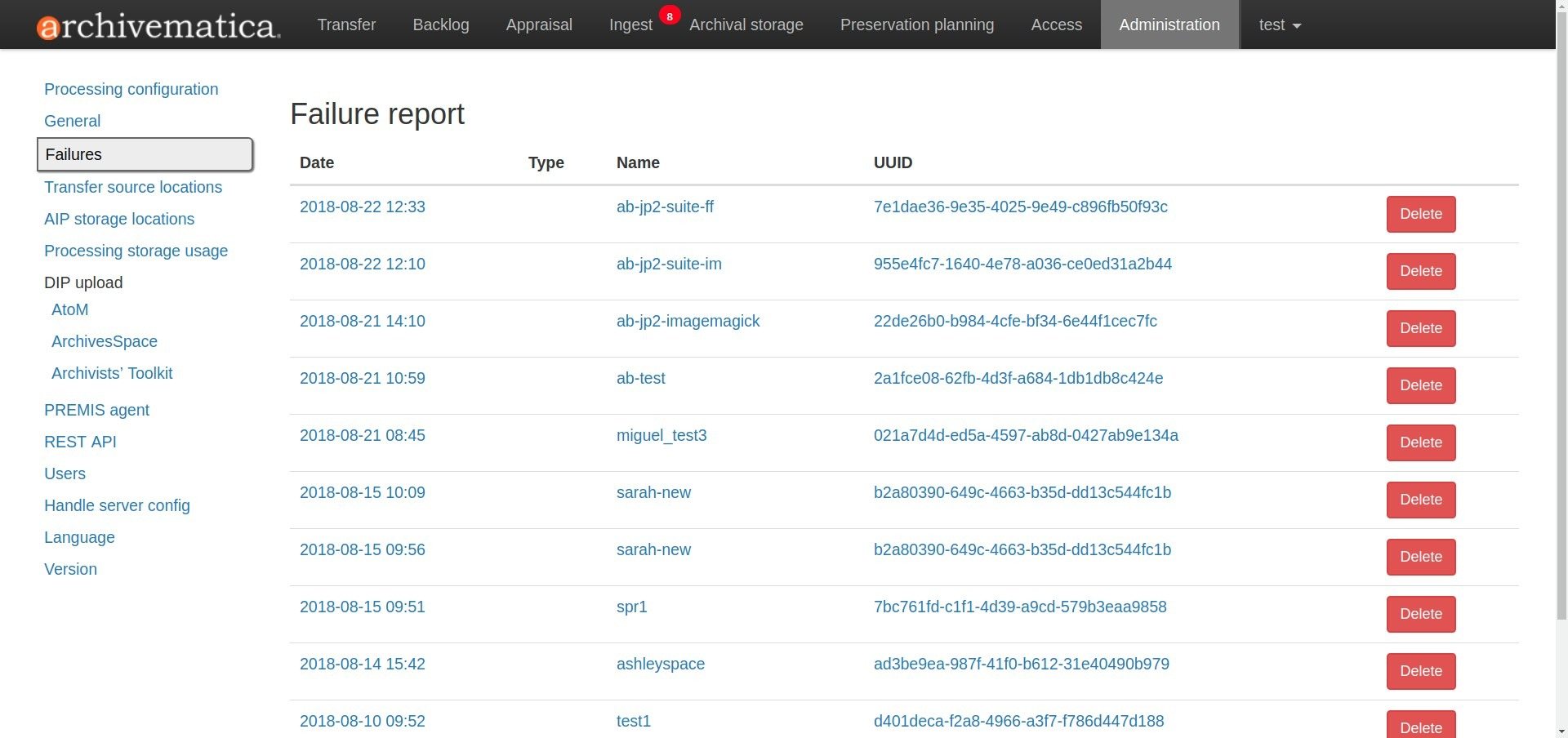Dashboard administration tab¶
This page describes dashboard user administration in Archivematica via the dashboard. For higher level, technical administrative documentation, please see Administrator manual.
The Archivematica administration pages, under the Administration tab of the dashboard, allows you to configure various parts of the application and manage integrations and users.
On this page:
- Processing configuration
- General
- Failures
- Transfer source locations
- AIP storage locations
- Processing storage usage
- DIP upload
- PREMIS agent
- REST API
- Users
- Handle server config
- Language
- Version
Processing configuration¶
The processing configuration administration page of the dashboard allows users to configure the job decision points presented by Archivematica during transfer and ingest. This screen provides you with an easy form to configure the default processingMCP.xml that governs these decisions. When you change the options using the web interface the necessary XML will be written behind the scenes.
Starting in 1.7, Archivematica includes both a default and an automated processing configuration. The automated processing configuration is used only if a transfer source location has been set up to move content through Archivematica with no human operator.
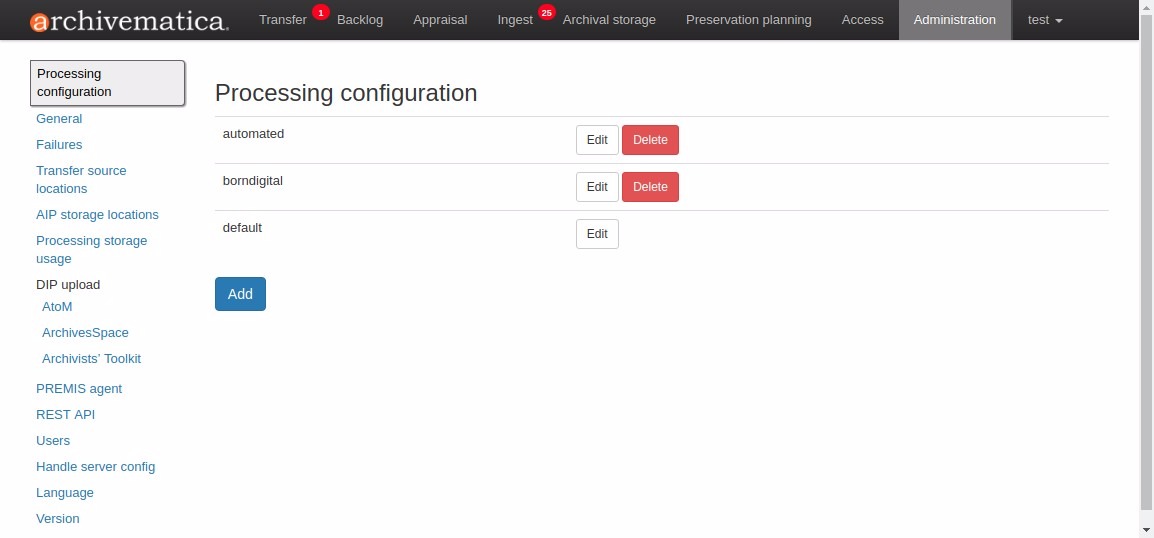
Multiple processing configurations can be created using the Add button on the Processing Configuration screen. Often, users create multiple configurations for different types of content - one for audio-visual material, one for images, one for textual records, etc. To edit an existing processing configuration file, click on the Edit button to the right of the processing configuration name.
Note that alternate processing configurations (i.e. anything other than default) are used in two ways:
- When you reingest an AIP, you are given the opportunity to select which processing configuration you’d like to use.
- You can download a specific processingMCP.xml via the command line and include it with a transfer. Archivematica will then use this to automate your transfer selections, rather than the default configuration. For more information on the processingMCP.xml file, see Creating a custom config with processingMCP.xml.
All other transfers will use the default processing configuration.
In order to edit any of the selections, select a choice from the drop-down menu to the right of the job name. Once you’ve made all of your selections, save the processing configuration. The fields are described in the next section.
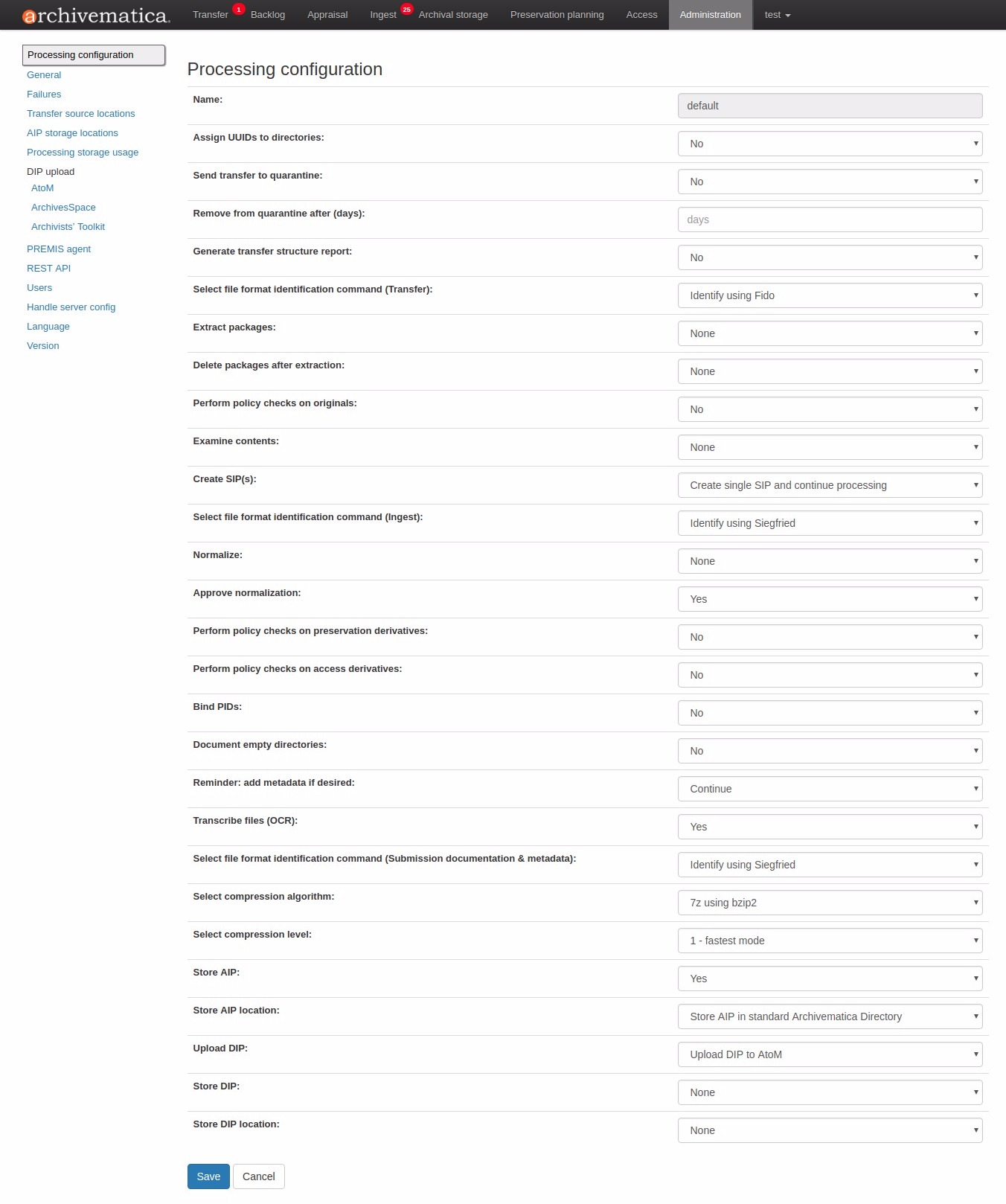
Processing configuration fields¶
Many jobs in the Archivematica transfer and ingest tabs have configurable decision points. Automating these decisions can make the transfer and ingest process substantially quicker, especially if you find yourself selecting the same decisions over and over. Below is a list of the processing configuration form fields with a short description about how they work and the drop-down options for each.
Name¶
The name of the processingMCP.xml that you are editing.
Assign UUIDs to directories¶
Directories are given an entry in the fileSec and assigned a unique universal identifier (UUID). Note that the digital objects in the transfer are always assigned a UUID.
Options:
- None - the user is prompted for a decision.
- Yes - UUIDs are assigned.
- No - UUIDs are not assigned.
Send transfer to quarantine¶
Transfers are sequestered until virus definitions can be updated.
Options:
- None - the user is prompted for a decision.
- Yes - transfers are automatically quarantined.
- No - transfers are not sent to quarantine.
Remove from quarantine after (days)¶
Transfers are automatically removed from quarantine after a defined number of days and made available for further processing.
Data entry field: Enter the number of days that transfers should remain in quarantine (i.e. 5).
Generate transfer structure report¶
A text file is generated showing a directory tree of the original transfer structure.
Options:
- None - the user is prompted for a decision.
- Yes - structure report is created.
- No - structure report is not created.
Select file format identification command (Transfer)¶
Choose a tool to identify the format of the files in your transfer.
Options:
- None - the user is prompted for a decision.
- Identify using Fido - use fido to identify files by their file signature.
- Skip File Identification - files will not be identified.
- Identify using Siegfried - use Siegfried to identify files by their signature.
- Identify by File Extension - identify files by their extension rather than signature.
Extract packages¶
Packages (such as .zip files) are unzipped and extracted into a directory.
Options:
- None - the user is prompted for a decision.
- Yes - the contents of the package are extracted.
- No - package is left as-is.
Delete packages after extraction¶
Packages that have been extracted in the previous step can be deleted after extraction.
Options:
- None - the user is prompted for a decision.
- Yes - the package is deleted.
- No - the package is preserved along with the extracted content.
Perform policy checks on originals¶
If you create policies using MediaConch, run the policies against the transfer to assess conformation.
Options:
- None - the user is prompted for a decision.
- Yes - the transfer is checked against any policies.
- No - policies are ignored.
Examine contents¶
Run Bulk Extractor, a forensics tool that can recognize credit card numbers, social security numbers, and other patterns in data. For more information on reviewing Bulk Extractor logs, see the Analysis pane on the Appraisal tab.
Options:
- None - the user is prompted for a decision.use
- Yes - Bulk Extractor scans content and creates log outputs of recognized patterns for review.
- No - Bulk Extractor does not run.
Create SIP(s)¶
Create a formal SIP out of the transfer or send it to the backlog.
Options:
- None - the user is prompted for a decision.
- Send to backlog - transfer is sent to a backlog storage space for temporary storage or appraisal.
- Create single SIP and continue processing - transfer becomes a SIP and is made available for further processing on the ingest tab.
Nota
If you are running Archivematica in indexless mode (without Elasticsearch), the backlog will be unavailable and the Send to backlog option will not be present in this dropdown.
Select file format identification command (Ingest)¶
Choose a tool to identify the format of files in your SIP.
Options:
- None - the user is prompted for a decision.
- Use existing data - reuse file identification data from the transfer tab.
- Identify using Fido - use fido to identify files by their file signature.
- Identify using Siegfried - use Siegfried to identify files by their signature.
- Identify by File Extension - identify files by their extension rather than their signature.
Normalize¶
Convert ingested digital objects to preservation and/or access formats. See Normalize for more information.
Options:
- None - the user is prompted for a decision.
- Normalize for preservation and access - creates preservation copies of the objects plus access copies which will be used to generate the DIP.
- Normalize for preservation - creates preservation copies only. No access copies are created and no DIP will be generated.
- Normalize manually - see Manual Normalization for more information.
- Do not normalize - the AIP will contain originals only. No preservation or access copies are generated and no DIP will be generated.
- Normalize service files preservation - see Digitization for more information.
- Normalize for access - the AIP will contain originals only. No preservation copies will be generated. Access copies will be created which will be used to generate the DIP.
Approve normalization¶
The dashboard allows users to review the normalization output and the normalization report.
Options:
- None - the user has a chance to review and approve normalization.
- Yes - skip the review step and automatically continue processing.
Perform policy checks on preservation derivatives¶
If you create policies using MediaConch, run the policies against the newly-created preservation derivatives to ensure conformation.
Options:
- None - the user is prompted for a decision.
- Yes - the normalized files are checked against any policies.
- No - policies are ignored.
Perform policy checks on access derivatives¶
If you create policies using MediaConch, run the policies against the newly-created preservation derivatives to ensure conformation.
Options:
- None - the user is prompted for a decision.
- Yes - the normalized files are checked against any policies.
- No - policies are ignored.
Bind PIDs¶
Assign persistent identifiers and send the information to a Handle Server (must be configured).
Options:
- None - the user is prompted for a decision.
- Yes - PIDs are created and a API call posts the PIDs to the Handle Server.
- No - PIDs are not created.
Document empty directories¶
By default, Archivematica removes empty directories and does not document that they existed.
Options:
- None - the user is prompted for a decision.
- Yes - an entry for the directory is created in the structmap.
- No - the directory is not documented.
Reminder: add metadata if desired¶
Archivematica allows users to see add metadata to the SIP using the GUI. This reminder occurs at the last moment that it is possible to add metadata; once the ingest proceeds past this point, it is no longer possible to add metadata to the SIP.
Options:
- None - the user has a chance to add metadata.
- Continue - skip the reminder and automatically continue processing.
Transcribe files (OCR)¶
Users can elect to run Tesseract, an OCR tool that is included in Archivematica, to produce text files containing file transcripts. For more information, see (see Transcribe SIP contents).
Options:
- None - the user is prompted for a decision.
- Yes - Tesseract runs on all OCR-able files.
- No - Tesseract does not run.
Select file format identification command (Submission documentation & metadata)¶
Choose a tool to identify the format of any submission documentation and/or metadata files that were included in your transfer.
Options:
- None - the user is prompted for a decision.
- Identify using Siegfried - use Siegfried to identify files by their signature.
- Identify using Fido - use fido to identify files by their file signature.
- Identify by File Extension - identify files by their extension rather than their signature.
- Skip File Identification - file identification is not run on submission documentation or metadata files.
Select compression algorithm¶
AIPs created by Archivematica can be stored as compressed packages or uncompressed, depending on your storage requirements.
Options:
- None - the user is prompted for a decision.
- 7z using bzip2 - a 7Zip file is created using the tool bzip2.
- 7z using LZMA - a 7Zip file is created using the tool LZMA.
- Uncompressed - the AIP is not compressed.
- Parallel bzip2 - a 7Zip file is created using the tool Parallel bzip2 (pbzip2).
Select compression level¶
If you selected a compression choice in the step above, you can determine how compressed you would like your AIP to be. Selecting a higher compression level means that the resulting AIP is smaller, but compression also takes longer. Lower compression levels mean quicker compression, but a larger AIP.
Options:
- None - the user is prompted for a decision.
- 5 - normal compression mode - the compression tool will strike a balance between speed and compression to make a moderately-sized, moderately-compressed AIP.
- 7 - maximum compression - a smaller AIP that takes longer to compress.
- 9 - ultra compression - the smallest possible AIP.
- 3 - fast compression mode - a larger AIP that will be compressed quickly.
- 1 - fastest mode - the AIP will be compressed as quickly as possible.
Store AIP¶
Once processing is complete, AIPs can be stored without interrupting the workflow in the dashboard.
Options:
- None - the user is prompted for a decision.
- Yes - the AIP is marked for storage automatically.
Store AIP location¶
If the previous step and this step are configured, all AIPs will be sent to the selected storage location (unless you have included a custom processing configuration with the transfer that defines another location).
Options:
- None - the user is prompted for a decision.
- Default location - the AIP is stored in the AIP storage location that has been defined as the default in the Storage Service.
- [Other storage locations] - any other AIP storage locations that are available will also appear on this list.
Upload DIP¶
If a DIP was created, it can be automatically sent to an access system for which there is an Archivematica integration.
Options:
- None - the user is prompted for a decision.
- Upload DIP to CONTENTdm - see CONTENTdm DIP upload documentation.
- Upload DIP to Archivists Toolkit - see Archivists Toolkit DIP upload documentation.
- Upload DIP to AtoM - see AtoM DIP upload documentation.
- Do not upload - the DIP will not be uploaded to an access system.
- Upload DIP to ArchivesSpace - see ArchivesSpace DIP upload documentation.
Store DIP¶
If a DIP was created, it can be stored without interrupting the workflow in the dashboard. Note that DIP storage is not required, and that DIPs can be created on demand by reingesting the AIP.
Options:
- None - the user is prompted for a decision.
- Yes - the DIP is marked for storage automatically.
Store DIP location¶
If the previous step and this step are configured, all DIPs will be sent to the selected storage location (unless you have included a custom processing configuration with the transfer that defines another location).
Options:
- None - the user is prompted for a decision.
- Default location - the DIP is stored in the DIP storage location that has been defined as the default in the Storage Service.
- [Other storage locations] - any other DIP storage locations that are available will also appear on this list.
General¶
In this section, you can configure the following for your Archivematica client:
- Storage Service options
- Checksum algorithm
- Elasticsearch indexing
Storage Service options¶
This is where you’ll find the complete URL for the Storage Service, along with a username and API key. See the Storage Service documentation for more information about this feature.
Checksum algorithm¶
You can select which checksum algorithm Archivematica will use during the Assign UUIDs and checksums micro-service in Transfer. Choose between MD5, SHA-1, SHA-256 and SHA-512.
Elasticsearch indexing¶
As of Archivematica 1.7, Elasticsearch is optional. Installing Archivematica without Elasticsearch means reduced consumption of compute resources and lower operational complexity. Disabling Elasticsearch means that the Backlog, Appraisal, and Archival Storage tabs do not appear and their functionality is not available.
This section in the General configuration shows if Elasticsearch is enabled or disabled.
Failures¶
This page displays packages that failed during processing.
Clicking the date, name or UUID will display a report of the failure:
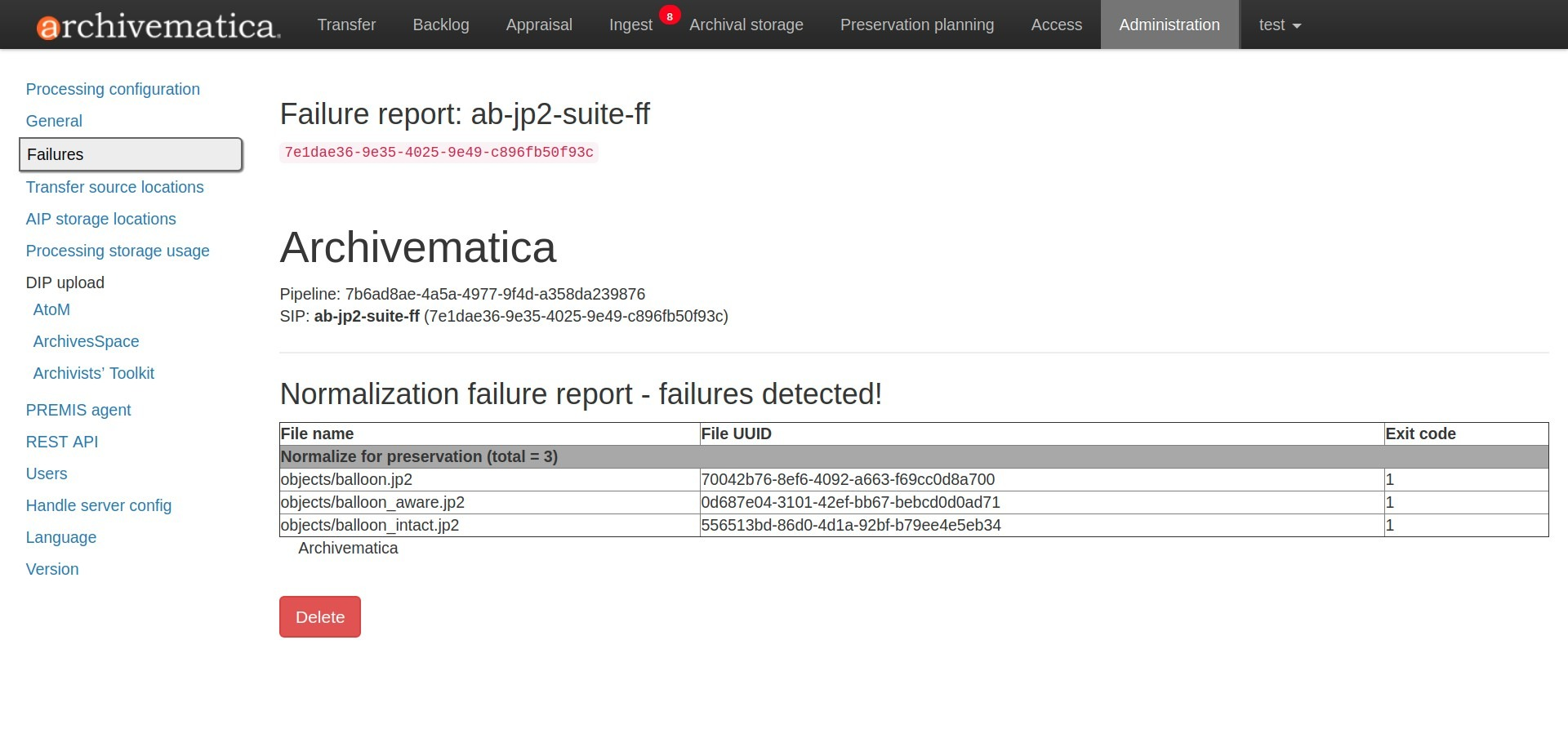
The failure report can be removed from the Dashboard by clicking Delete.
Transfer source location¶
Archivematica allows you to start transfers using the operating system’s file browser or via a web interface. Source files for transfers, however, cannot be uploaded using the web interface; they must exist on volumes accessible to the Archivematica MCP server and configured via the Storage Service.
When starting a transfer you are required to select one or more directories of files to add to the transfer.
AIP storage locations¶
AIP storage directories are directories in which completed AIPs are stored. Storage directories can be specified in a manner similar to transfer source directories using the Storage Service.
You can view your transfer source directories in the Administrative tab of the dashboard under «AIP storage locations».
Processing storage usage¶
This section of the Administration page displays various processing locations with their current usage of available space.
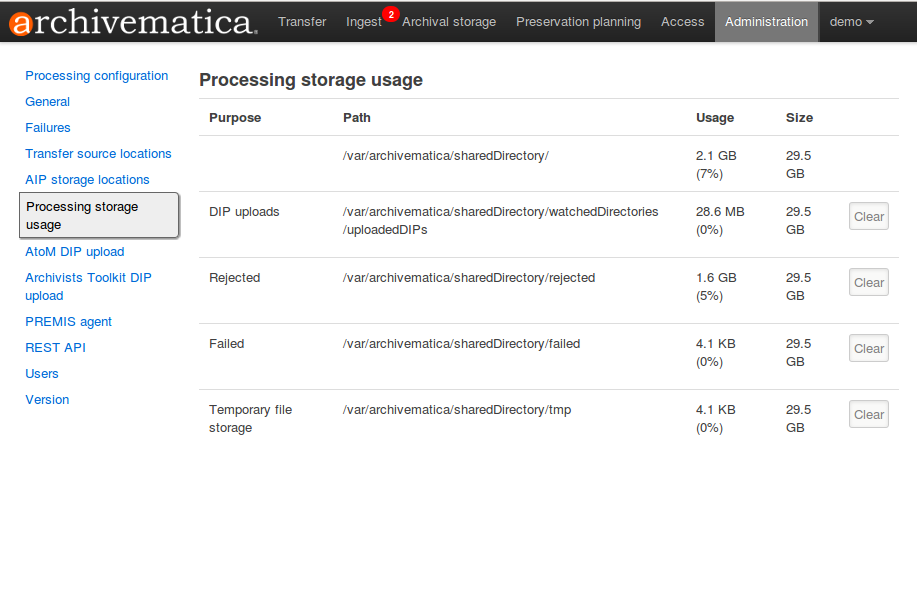
Administrators can use the «clear» buttons to delete the contents of these processing locations to make more room on their server.
DIP upload¶
Archivematica has access integrations with three access platforms: AtoM, ArchivesSpace, and Archivists” Toolkit.
AtoM DIP upload¶
Archivematica can upload DIPs directly to an AtoM website so that the contents can be accessed online. The AtoM DIP upload configuration page is where you specify the AtoM installation where you’d like to upload DIPs (and, if you are using Rsync to transfer the DIP files, the Rsync transfer details).
For more information on configuring the AtoM DIP upload parameters and the servers, please see the Admin Manual AtoM DIP upload configuration instructions.
Levels of description
You can fetch levels of description from AtoM so that they can be used in SIP arrange. Click on Levels of Description, then Fetch from AtoM to get an updated list from the AtoM levels of description taxonomy.
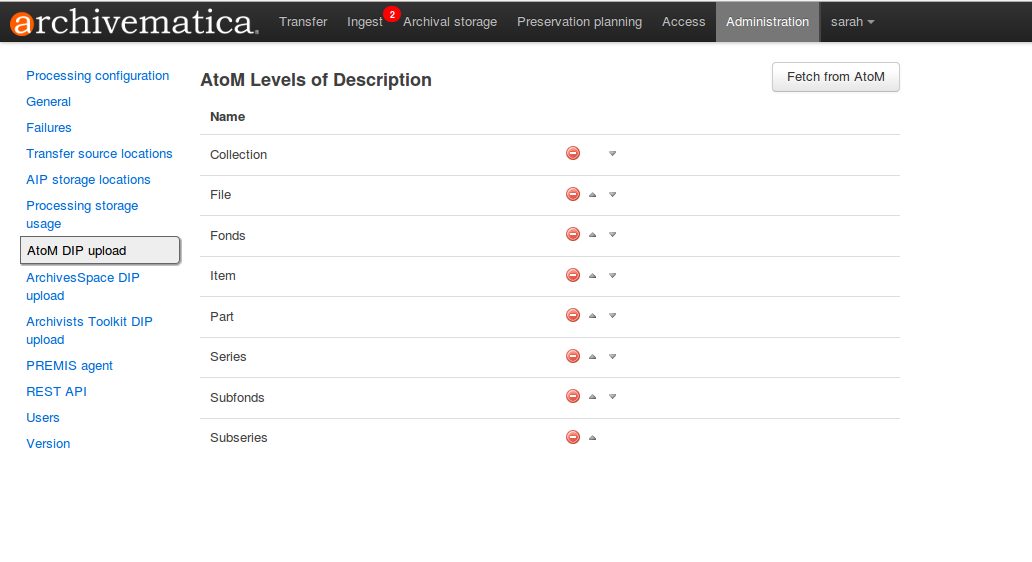
If there are levels of description in the AtoM taxonomy that you prefer not to use in Archivematica SIP arrange, you can remove them using the red delete button. You can change the order that they appear in SIP arrange by using the up/down arrows in this screen.
Nota
You may need an administrator to configure AtoM for DIP uploads from Archivematica. For administrator instructions, see AtoM DIP upload in the Administrator manual
ArchivesSpace DIP upload¶
Before ingesting digital objects destined for ArchivesSpace, ensure that the ArchivesSpace DIP upload settings in the administration tab of the dashboard have been set.
For more information on configuring the ArchivesSpace DIP upload parameters, please see the Admin Manual ArchivesSpace DIP upload configuration instructions.
Archivists Toolkit DIP upload¶
Before ingesting digital objects destined for Archivists” Toolkit, ensure that the Achivists” Toolkit DIP upload settings in the administration tab of the dashboard have been set.
Should you wish to enable the PREMIS-based restrictions functionality, choose base on PREMIS under Restrictions Apply. To add PREMIS rights, please see Add PREMIS rights and restrictions.
For more information on configuring the Archivists” Toolkit DIP upload parameters, please see the Admin Manual Archivists” Toolkit DIP upload configuration instructions.
Ver también
Importante
We no longer actively test DIP uploads to Archivists” Toolkit.
PREMIS agent¶
The PREMIS agent name and code can be set via the administration interface.
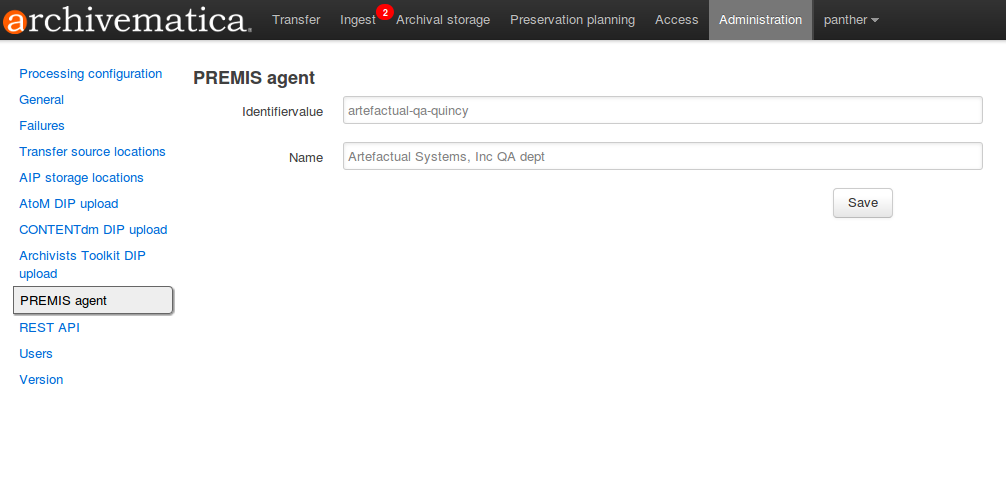
The PREMIS agent information is used in the METS files created by Archivematica to identify the agency performing the digital preservation events.
REST API¶
Archivematica includes a REST API for automating transfer approval. Artefactual recommends that a technical administrator configure the options for this feature.
To configure Archivematica to use the REST API for automation, see Administrator manual - REST API.
Users¶
The dashboard provides a simple cookie-based user authentication system using the Django authentication framework. Access to the dashboard is limited only to logged-in users and a login page will be shown when the user is not recognized. If the application can’t find any user in the database, the user creation page will be shown instead, allowing the creation of an administrator account.
Users can be also created, modified and deleted from the Administration tab. Only users who are administrators can create and edit user accounts.
You can add a new user to the system by clicking the «Add new» button on the user administration page. By adding a user you provide a way to access Archivematica using a username/password combination. Should you need to change a user’s username or password, you can do so by clicking the «Edit» button, corresponding to the user, on the administration page. Should you need to revoke a user’s access, you can click the corresponding «Delete» button.
For more information about user creation, deletion, and security, please see the Users section in the Admin Manual.
Handle Server config¶
Archivematica can to be configured to make requests to a Handle System HTTP API so that files, directories and entire AIPs can be assigned persistent identifiers (PIDS) and derived persistent URLs (PURLs).
Language¶
The Archivematica dashboard is in the process of being translated. For more information, see Translations.



